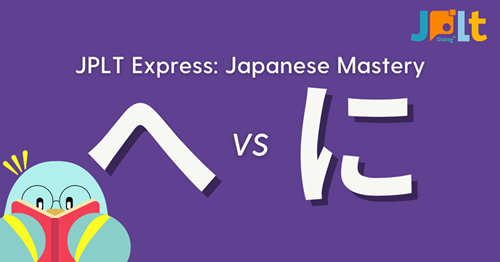Tips for beginners in Japanese: What is the difference between “へ(he)” and “に(ni)”?
Explaining the difference between “へ” and “に” in Japanese
For Japanese learners, distinguishing between the uses of “へ” and “に” can often be challenging. Indeed, both are used in conjunction with the verb “to go,” but it becomes clearer when you consider that “へ” indicates direction or movement, while “に” indicates a destination or a place of existence.
 Difference in indicating movement direction and destination
Difference in indicating movement direction and destination
-
“へ”:
Indicates the direction of movement. It emphasizes the distance to the destination and the state of not having arrived yet.
-
“に”:
Indicates the destination. It emphasizes the state of having arrived at the destination.
 Let’s compare with examples:
Let’s compare with examples:
-
“学校へ行く” (Going to school):
Indicates heading towards school from home. It implies not having arrived at school yet.
-
“学校に行く” (Going to school):
Indicates arriving at school and entering the school building. It implies already being at school.
![]()
↑↑Click the image above to register↑↑
![]()
 Difference as figurative expressions
Difference as figurative expressions
-
“へ”:
Used as a figure of speech to depict a long and challenging journey to the destination.
-
“に”:
Used as a metaphorical expression to depict a short and easy journey to the destination.
 Let’s compare with examples:
Let’s compare with examples:
-
“山頂へ登る” (Climbing to the mountaintop):
Indicates a difficult and challenging journey to the mountaintop.
-
“山頂に行く” (Going to the mountaintop):
Indicates an easy journey to the mountaintop.
 Difference in expressing emotions and intentions
Difference in expressing emotions and intentions
-
“へ”:
Carries nuances of strong will or determination towards the destination.
-
“に”:
Carries nuances of a natural flow or habit towards the destination.
 Let’s compare with examples:
Let’s compare with examples:
-
“新しいレストランへ行く” (Going to a new restaurant):
Indicates a strong desire to try out a new restaurant.
-
“毎日学校に行く” (Going to school every day):
Indicates the habit of going to school every day.
In summary
“へ” and “に” have various differences such as indicating movement direction and destination, metaphorical expressions, and expressing emotions or will. Being aware of these differences enables more natural Japanese expressions.
Additional notes:
The above are basic nuances, and subtle differences may arise depending on the context. Until you get used to it, “に” tends to be more versatile and easier to use in many situations. Good luck with your Japanese learning journey!







